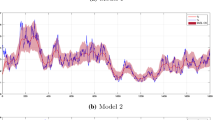Abstract
Estimation of the tail index of stationary, fat-tailed return distributions is non-trivial since the well-known Hill estimator is optimal only under iid draws from an exact Pareto model. We provide a small sample simulation study of recently suggested adaptive estimators under ARCH-type dependence. The Hill estimator’s performance is found to be dominated by a ratio estimator. Dependence increases estimation error which can remain substantial even in larger data sets. As small sample bias is related to the magnitude of the tail index, recent standard applications may have overestimated (underestimated) the risk of assets with low (high) degrees of fat-tailedness.
Similar content being viewed by others
References
Blattberg, R. C., Gonedes, N. J. (1974): A Comparison of Stable and Student Distributions as Statistical Models for Stock Prices,Journal of Business 47: 244–280.
Dacorogna, M. M., Müller, U. A., Pictet, O. V., de Vries, C. G. (1995): The Distribution of Extremal Foreign Exchange Rate Returns in Extremely Large Data Sets, O&A Preprint, Zürich
Danielsson, J., de Haan, L., Peng, L., de Vries, C. G. (2001): Using a Bootstrap Method to Choose the Sample Fraction in Tail Index Estimation,Journal of Multivariate Analysis 76: 226–248
Danielsson, J., Jansen, D. W., de Vries, C. G. (1996): The Method of Moments Estimator for the Tail Shape Parameter,Communications in Statistics-Theory and Methods 25: 711–720.
Danielsson, J., de Vries, C. G. (1997a): Tail Index and Quantile Estimation with Very High Frequency Data,Journal of Empirical Finance 4: 241–257.
Danielsson, J., de Vries, C. G. (1997b): Beyond the Sample: Extreme Quantile and Probability Estimation, Working Paper, Erasmus University Rotterdam
Dewachter, H., Gielens, G. (1994): A Note on the Sum-Stability of Speculative Returns,Economic Notes 23: 116–124.
Drees, H. (1998): Optimal Rates of Convergence for Estimates of the Extreme Value Index,Annals of Statistics 26: 434–448.
Drees, H., de Haan, L., Resnick, S. (2000): How to Make a Hill Plot,Annals of Statistics 28: 254–274.
Drees, H., Kaufmann, E. (1998): Selecting the Optimal Sample Fraction in Univariate Extreme Value Estimation,Stochastic Processes and their Application 75: 149–172.
Embrechts, P., Klüppelberg, C., Mikosch, T. (1997): Modelling Extremal Events for Insurance and Finance, Springer, New York
Fisher, R. A., Tippett, L. H. C. (1928): Limiting Forms of the Frequency Distribution of the Largest or Smallest Member of a Sample,Proceedings of the Cambridge Philosophical Society 24: 180–183.
Gnedenko, B. V. (1943): Sur la Distribution Limite du Terme Maximum d'une Serie Aleatoire,Annals of Mathematics 44: 423–453
de Haan, L., Peng, L. (1998): Comparison of Tail Index Estimators,Statistica Neerlandica 52: 60–70.
Hall, P. (1990): Using the Bootstrap to Estimate Mean Squared Error and Select Smoothing Parameters in Nonparametric Problems,Journal of Multivariate Analysis 32: 177–203.
Hill, B. M. (1975): A Simple General Approach to Inference about the Tail of a Distribution,Annals of Statistics 3: 1163–1174.
Hsing, T. (1991): On Tail Index Estimation using Dependent Data,Annals of Statistics 19: 1547–1569.
Huisman, R., Koedijk, K. G., Kool, C., Palm, F. C. (2001): Tail-Index Estimates in Small Samples,Journal of Business and Economic Statistics 19: 208–216.
Janicki, A., Weron, A. (1993): Simulation and Chaotic Behavior of α-Stable Stochastic Processes, Dekker, New York
Jondeau, E., Rockinger, M. (1999): The Tail Behavior of Stock Returns: Emerging versus Mature Markets, Working Paper, HEC-School of Management
Kearns, P. Pagan, A. (1997): Estimating the Density Tail Index for Financial Times Series,Review of Economics and Statistics 79: 171–175.
Koedijk, K. G., Schafgans, M. M., de Vries, C. G. (1990): The Tail Index of Exchange Rate Returns.Journal of International Economics 29: 93–108.
Lux, T. (2001): The Limiting Extremal Behavior of Speculative Returns: An Analysis of Intra-Daily Data from the Frankfurt Stock Exchange,Applied Financial Economics 11: 299–315.
McNeil, A. J., Frey, R. (2000): Estimation of Tail-Related Measures for Heteroscedastic Financial Time Series: An Extreme Value Approach,Journal of Empirical Finance 7: 271–300.
Mikosch, T., St^aricâ, C. (2000): Limit Theory for the Sample Autocor-relations and Extremes of a GARCH(1,1) Process,Annals of Statistics 28: 1427–1451
Resnick, S., Stâricâ, C. (1998) Tail Index Estimation for Dependent Data,Annals of Applied Probability 8: 1156–1183
Author information
Authors and Affiliations
Additional information
This paper is a shortened version of the Berkeley Research Program in Finance Working Paper RPF-295. Thanks are to the Center for Mathematical Sciences at Munich University of Technology for generously providing access to computer facilities and to participants at the IAFE 2001 Budapest, OR 2002 Klagenfurt, EIR 2002 London, DGF 2002 Cologne, FBI 2002 Karlsruhe conferences and the 2001 Wallis Workshop for helpful comments. Two anonymous referees provided helpful suggestions in streamlining the material. Niklas Wagner acknowledges a Maple program by Klaus Kiefersbeck and financial support by Deutsche Forschungsgemeinschaft (DFG).
Rights and permissions
About this article
Cite this article
Wagner, N., Marsh, T.A. Tail index estimation in small smaples Simulation results for independent and ARCH-type financial return models. Statistical Papers 45, 545–561 (2004). https://doi.org/10.1007/BF02760567
Received:
Revised:
Issue Date:
DOI: https://doi.org/10.1007/BF02760567




